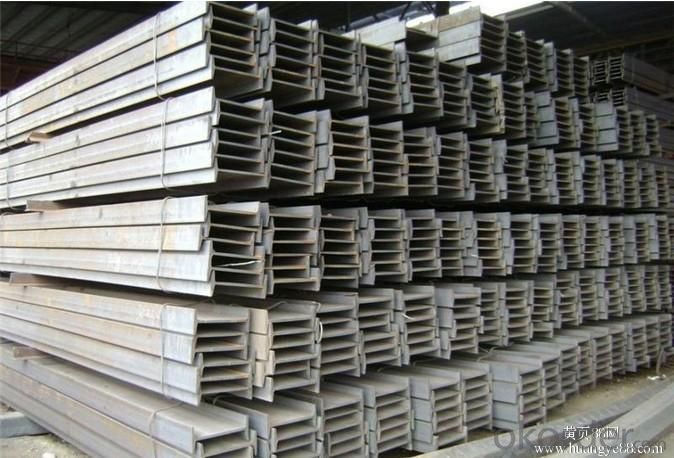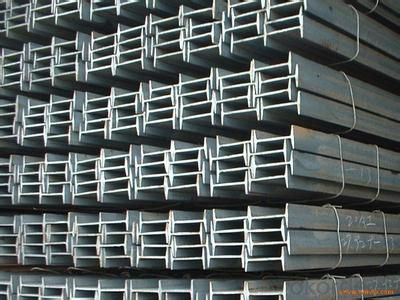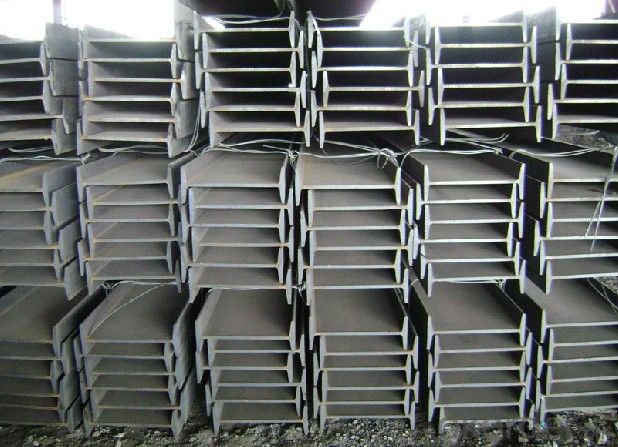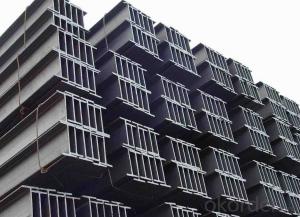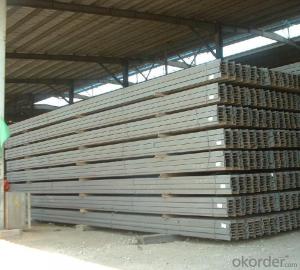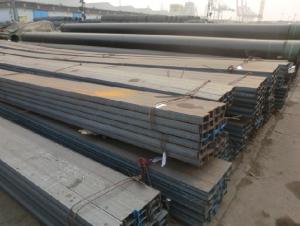Q235 Barbon Steel I Beam Bar
- Loading Port:
- China Main Port
- Payment Terms:
- TT or LC
- Min Order Qty:
- -
- Supply Capability:
- -
OKorder Service Pledge
OKorder Financial Service
You Might Also Like
Product Description:
OKorder is offering Q235 Barbon Steel I Beam Barat great prices with worldwide shipping. Our supplier is a world-class manufacturer of steel, with our products utilized the world over. OKorder annually supplies products to European, North American and Asian markets. We provide quotations within 24 hours of receiving an inquiry and guarantee competitive prices.
Product Applications:
Q235 Barbon Steel I Beam Bar are ideal for structural applications and are widely used in the construction of buildings and bridges, and the manufacturing, petrochemical, and transportation industries.
Product Advantages:
OKorder's Q235 Barbon Steel I Beam Bar are durable, strong, and resist corrosion.
Main Product Features:
· Premium quality
· Prompt delivery & seaworthy packing (30 days after receiving deposit)
· Corrosion resistance
· Can be recycled and reused
· Mill test certification
· Professional Service
· Competitive pricing
Product Specifications:
Manufacture: Hot rolled
Grade: Q195 – 235
Certificates: ISO, SGS, BV, CIQ
Length: 6m – 12m, as per customer request
Packaging: Export packing, nude packing, bundled
Chinese Standard (H*W*T) | Weight (Kg/m) | 6m (pcs/ton) | Light I (H*W*T) | Weight (Kg/m) | 6m (pcs/ton) | Light II (H*W*T) | Weight (Kg/m) | 6M |
100*68*4.5 | 11.261 | 14.8 | 100*66*4.3 | 10.13 | 16.4 | 100*64*4 | 8.45 | 19.7 |
120*74*5.0 | 13.987 | 11.9 | 120*72*4.8 | 12.59 | 13.2 | 120*70*4.5 | 10.49 | 15.8 |
140*80*5.5 | 16.89 | 9.8 | 140*78*5.3 | 15.2 | 10.9 | 140*76*5 | 12.67 | 13.1 |
160*88*6 | 20.513 | 8.1 | 160*86*5.8 | 18.46 | 9 | 160*84*5.5 | 15.38 | 10.8 |
180*94*6.5 | 24.143 | 6.9 | 180*92*6.3 | 21.73 | 7.6 | 180*90*6 | 18.11 | 9.2 |
200*100*7 | 27.929 | 5.9 | 200*98*6.8 | 25.14 | 6.6 | 200*96*6.5 | 20.95 | 7.9 |
220*110*7.5 | 33.07 | 5 | 220*108*7.3 | 29.76 | 5.6 | 220*106*7 | 24.8 | 6.7 |
250*116*8 | 38.105 | 4.3 | 250*114*7.8 | 34.29 | 4.8 | 250*112*7.5 | 28.58 | 5.8 |
280*122*8.5 | 43.492 | 3.8 | 280*120*8.2 | 39.14 | 4.2 | 280*120*8 | 36.97 | 4.5 |
300*126*9 | 48.084 | 3.4 | 300*124*9.2 | 43.28 | 3.8 | 300*124*8.5 | 40.87 | 4 |
320*130*9.5 | 52.717 | 3.1 | 320*127*9.2 | 48.5 | 3.4 | |||
360*136*10 | 60.037 | 2.7 | 360*132*9.5 | 55.23 | 3 |
FAQ:
Q1: Why buy Materials & Equipment from OKorder.com?
A1: All products offered byOKorder.com are carefully selected from China's most reliable manufacturing enterprises. Through its ISO certifications, OKorder.com adheres to the highest standards and a commitment to supply chain safety and customer satisfaction.
Q2: How do we guarantee the quality of our products?
A2: We have established an advanced quality management system which conducts strict quality tests at every step, from raw materials to the final product. At the same time, we provide extensive follow-up service assurances as required.
Q3: How soon can we receive the product after purchase?
A3: Within three days of placing an order, we will begin production. The specific shipping date is dependent upon international and government factors, but is typically 7 to 10 workdays.
Q4: What makes stainless steel stainless?
A4: Stainless steel must contain at least 10.5 % chromium. It is this element that reacts with the oxygen in the air to form a complex chrome-oxide surface layer that is invisible but strong enough to prevent further oxygen from "staining" (rusting) the surface. Higher levels of chromium and the addition of other alloying elements such as nickel and molybdenum enhance this surface layer and improve the corrosion resistance of the stainless material.
Q5: Can stainless steel rust?
A5: Stainless does not "rust" as you think of regular steel rusting with a red oxide on the surface that flakes off. If you see red rust it is probably due to some iron particles that have contaminated the surface of the stainless steel and it is these iron particles that are rusting. Look at the source of the rusting and see if you can remove it from the surface.
Images:
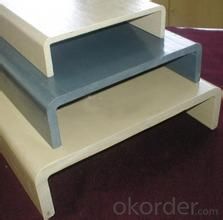
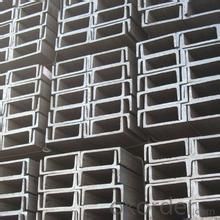
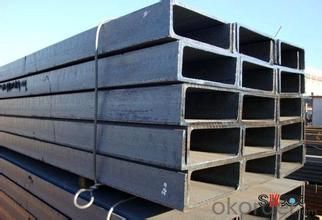
- Q:What is the difference between the support of shed support and the support of joist support in coal mine?
- I-beam is more stable, and I-beam is used in the mine with high pressure and deep well.The joist shed is mainly used for permanent support.
- Q:Can steel I-beams be used for industrial platforms?
- Yes, steel I-beams can be used for industrial platforms. They are commonly used due to their high strength and load-bearing capacity, making them suitable for supporting heavy equipment and machinery in industrial settings.
- Q:How do steel I-beams perform in high-wind stadium applications?
- Due to their superior performance in high-wind stadium applications, steel I-beams are commonly utilized. The exceptional design of I-beams, which includes flanges that resist bending and a web that resists shear, makes them highly effective in withstanding the forces exerted by strong winds. In environments with strong winds, the aerodynamic shape of stadiums can generate significant wind loads on the structure. Steel I-beams are capable of efficiently distributing these loads, ensuring the stability and integrity of the stadium. Steel's high strength-to-weight ratio permits the construction of spacious, open areas without compromising structural stability. Furthermore, steel I-beams possess remarkable durability and resistance to corrosion, making them suitable for long-term use in outdoor stadium settings. Their ability to endure extreme weather conditions, such as high winds, guarantees the safety of spectators and the longevity of the structure. Moreover, steel I-beams can be easily fabricated and installed, facilitating efficient construction processes in stadium applications. Steel's versatility enables customization to meet specific design requirements, ensuring that the stadium can accommodate large crowds while maintaining structural integrity. In conclusion, steel I-beams are an outstanding choice for high-wind stadium applications due to their efficient distribution of wind loads, durability in harsh weather conditions, and ease of fabrication and installation.
- Q:How do you transport and store steel I-beams?
- Steel I-beams are typically transported using flatbed trucks or trailers equipped with overhead cranes or forklifts. They are secured using chains or straps to prevent shifting or damage during transit. When it comes to storage, steel I-beams should be stored in a dry and well-ventilated area to prevent rusting. They can be stacked on a level surface, ideally using proper bracing or supports to avoid deformation or collapse. Additionally, it is important to keep them protected from moisture and corrosive substances by covering them with a tarp or using appropriate coatings.
- Q:Can steel I-beams be used in coastal areas with high humidity?
- Yes, steel I-beams can be used in coastal areas with high humidity. However, it is important to consider the potential impact of the corrosive effects of saltwater and high humidity on the steel beams. In such coastal environments, the steel beams should be properly coated or protected to prevent corrosion. This can be achieved through the use of corrosion-resistant coatings, such as galvanization or epoxy paint. Regular inspections and maintenance should also be carried out to identify and address any signs of corrosion, as well as to ensure the structural integrity of the steel beams. By taking these precautions, steel I-beams can be effectively used in coastal areas with high humidity.
- Q:Are steel I-beams cost-effective compared to other materials?
- Yes, steel I-beams are generally considered to be cost-effective compared to other materials in many construction applications. Steel is a highly durable and versatile material that provides excellent structural support and load-bearing capability, making it suitable for a wide range of projects such as bridges, high-rise buildings, and industrial structures. One of the key advantages of steel I-beams is their strength-to-weight ratio. Steel is significantly stronger than materials like wood or concrete, allowing for the design of more efficient and lighter structures. This not only reduces the overall cost of construction but also minimizes the amount of material required, resulting in savings in transportation and labor costs. Additionally, steel is a readily available material with a well-established supply chain, making it more cost-effective compared to other materials that may be less accessible or have limited availability. It also offers flexibility in terms of design, allowing for customization and easy integration with other building components. Moreover, steel I-beams have a long lifespan and require minimal maintenance, which further contributes to their cost-effectiveness. Steel is highly resistant to corrosion, fire, and pests, ensuring durability and longevity. Consequently, the reduced need for repairs or replacements over time translates into long-term cost savings for building owners. However, it is worth noting that the cost-effectiveness of steel I-beams can vary depending on factors such as project requirements, location, and market conditions. While steel is generally affordable, fluctuations in raw material prices and market demand can impact the overall cost. Therefore, it is crucial to evaluate the specific needs of each project and consider the current market dynamics when determining the cost-effectiveness of steel I-beams compared to other materials.
- Q:Can steel I-beams be custom fabricated?
- Certainly! Steel I-beams can indeed be custom fabricated. Custom fabrication of steel I-beams pertains to the manufacturing procedure of these structural components in accordance with precise design requisites, encompassing distinct measurements, lengths, and load-bearing capacities. This grants the opportunity for tailor-made solutions to address the specific requirements of diverse construction undertakings. The process of custom fabrication of steel I-beams entails cutting, welding, and molding the steel in order to attain the desired specifications. This task is typically executed by seasoned steel fabricators who possess the expertise, aptitude, and apparatus to undertake such ventures. The capability to custom fabricate steel I-beams is of utmost importance in numerous industries, including construction, engineering, and architecture, as it facilitates the establishment of structures that are both secure and efficient.
- Q:How do steel I-beams perform in high humidity environments?
- The strength and durability of steel I-beams are widely recognized, and they exhibit excellent performance in high humidity conditions. Nevertheless, extended exposure to high humidity can potentially impact steel I-beams in various ways. One of the main concerns in high humidity settings is the potential for corrosion. When steel comes into contact with moisture, particularly in the presence of oxygen, it can undergo a chemical reaction and produce rust, which weakens its structural strength. The risk of corrosion may be elevated in areas with consistently high humidity. To counteract the effects of humidity on steel I-beams, several measures can be implemented. Firstly, the steel can be coated with protective coatings such as paint or galvanization. These coatings serve as a barrier against moisture and help prevent corrosion. Regular inspection and maintenance are also crucial for promptly identifying and addressing any signs of corrosion before they worsen. In addition, ensuring proper ventilation and humidity control within the environment can minimize the likelihood of moisture accumulation on the surface of steel I-beams. By maintaining relative humidity levels within recommended ranges, the risk of corrosion can be significantly reduced. In conclusion, while steel I-beams are generally dependable in high humidity environments, it is vital to employ protective measures and maintenance practices to ensure their long-term performance and structural integrity.
- Q:How much load can a steel I-beam support?
- The amount of load that a steel I-beam can support depends on several factors including the dimensions and material composition of the beam, as well as the manner in which it is supported. Steel I-beams are designed to carry heavy loads and are commonly used in construction projects such as bridges, buildings, and infrastructure. To determine the load capacity of a steel I-beam, engineers consider the beam's moment of inertia, section modulus, and yield strength. Moment of inertia measures the beam's resistance to bending, while section modulus represents its resistance to flexure. Yield strength, on the other hand, indicates the maximum amount of stress the beam can withstand without permanent deformation. To provide an estimate, a typical residential steel I-beam used as a structural support might be able to support a load ranging from a few hundred pounds up to several thousand pounds. However, it is important to consult with a structural engineer or a qualified professional who can accurately calculate the load capacity based on the specific dimensions and properties of the I-beam in question, as well as its intended application. It is worth noting that the load capacity of a steel I-beam can be increased by adding additional beams or by increasing their size. Reinforcing the beam with additional materials, such as concrete or other composite materials, can also enhance its load-carrying capacity. Ultimately, the load capacity of a steel I-beam is determined by a combination of factors, and a thorough analysis is required to provide an accurate answer based on the specific parameters of the beam and its intended use.
- Q:What are the design considerations for steel I-beams in high-seismic zones?
- Design considerations for steel I-beams in high-seismic zones are crucial in order to ensure the structural integrity and safety of buildings. Here are some important factors that need to be taken into account: 1. Seismic forces: High-seismic zones are prone to intense ground shaking during earthquakes. Therefore, the design of steel I-beams must consider the expected seismic forces, which are influenced by factors such as the location, soil conditions, and the magnitude of potential earthquakes. These forces need to be calculated accurately to determine the appropriate size and strength of the I-beams. 2. Ductility: Ductility refers to a material's ability to undergo significant deformation before failure. In high-seismic zones, it is essential to design steel I-beams with high ductility. This allows the beams to absorb and dissipate seismic energy, redistributing it throughout the structure and reducing the risk of catastrophic failure. To enhance ductility, specific steel grades and reinforcement detailing techniques can be employed. 3. Connection design: The connections between steel I-beams and other structural elements, such as columns and foundations, are critical in high-seismic zones. These connections must be designed to withstand the seismic forces and ensure a continuous load path throughout the structure. Special attention should be given to connection detailing, weld quality, and bolted connections to ensure adequate strength and ductility. 4. Redundancy: Redundancy in structural systems refers to the provision of multiple load paths. In high-seismic zones, it is important to have redundant systems to ensure that the structure remains intact even if some elements experience damage. Steel I-beams with redundant load paths can provide backup support and prevent progressive collapse during seismic events. 5. Material selection: The choice of steel grade is crucial in high-seismic zones. High-strength steel with good ductility, such as ASTM A992 or A913, is often preferred. These materials offer excellent performance under seismic loading and have superior resistance to fracture and deformation. The selection of material should consider factors like yield strength, toughness, and weldability. 6. Code compliance: Designing steel I-beams in high-seismic zones must comply with relevant building codes and standards. These codes provide guidelines for seismic design criteria, load combinations, detailing requirements, and other safety considerations. It is essential to stay up-to-date with the latest codes and ensure the design adheres to the specified requirements. Overall, the design considerations for steel I-beams in high-seismic zones revolve around seismic forces, ductility, connection design, redundancy, material selection, and code compliance. By addressing these factors, engineers can create robust and resilient structures that can withstand the potentially devastating effects of earthquakes.
1. Manufacturer Overview |
|
|---|---|
| Location | |
| Year Established | |
| Annual Output Value | |
| Main Markets | |
| Company Certifications | |
2. Manufacturer Certificates |
|
|---|---|
| a) Certification Name | |
| Range | |
| Reference | |
| Validity Period | |
3. Manufacturer Capability |
|
|---|---|
| a)Trade Capacity | |
| Nearest Port | |
| Export Percentage | |
| No.of Employees in Trade Department | |
| Language Spoken: | |
| b)Factory Information | |
| Factory Size: | |
| No. of Production Lines | |
| Contract Manufacturing | |
| Product Price Range | |
Send your message to us
Q235 Barbon Steel I Beam Bar
- Loading Port:
- China Main Port
- Payment Terms:
- TT or LC
- Min Order Qty:
- -
- Supply Capability:
- -
OKorder Service Pledge
OKorder Financial Service
Similar products
New products
Hot products
Hot Searches
Related keywords



